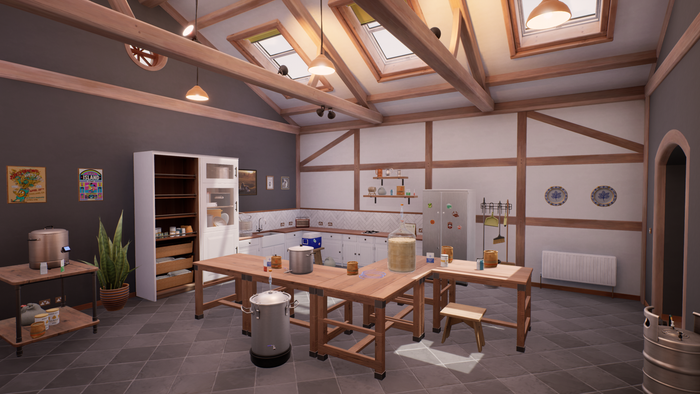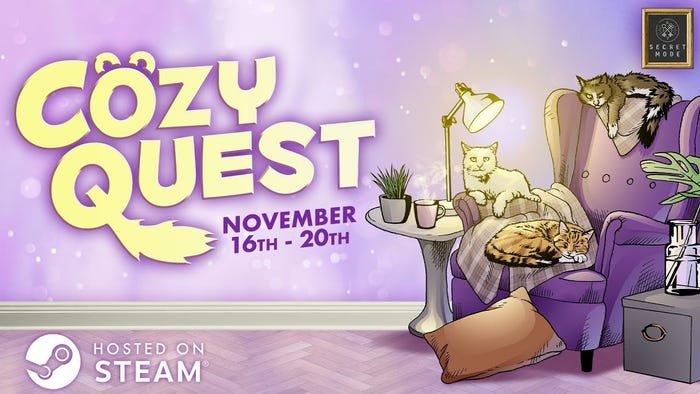Trending
Opinion: How will Project 2025 impact game developers?
The Heritage Foundation's manifesto for the possible next administration could do great harm to many, including large portions of the game development community.

Featured Blog | This community-written post highlights the best of what the game industry has to offer. Read more like it on the Game Developer Blogs or learn how to Submit Your Own Blog Post
Cosy gaming has always been and will continue to be a hotbed for creativity and fun both for players and developers.
March 1, 2024

Cosy gaming means something different to everyone. For some, it’s creating legacy save files spanning multiple generations on The Sims, for others it’s maintaining a bustling farm or town in games like Stardew Valley or Animal Crossing, and for others it’s putting items in their rightful place with a satisfying click like in A Little to the Left.
However you spend your cosy gaming time, one thing is always true: cosy games provide a respite and safe haven in an increasingly busy world and give us the opportunity to escape to lush environments, listen to peaceful music and experience relaxing gameplay. But where did cosy games come from? Just why are they so good for our busy brains? How can I get into cosy mode?
It's not very relaxing to sit with these questions on our mind so to put our brains at ease, Jess Rutland, Business Development at Auroch Digital, is taking a deep dive into the history of cosy games, the science behind them and taking a look at what’s next for the genre and how cosy questers can get their fill.

Cosy games will usually have defining characteristics, including satisfying gameplay, complementary colour-palettes and mindful music. In Brewmaster: Beer Brewing Simulator, players can create their own brews in a cosy, welcoming and calming environment.
Since the late 90s, cosy gaming has seen an increasing rise in mainstream prominence. With the genre having no rulebook of what makes a cosy game, there isn’t an ‘official’ start date for when cosy games began but it’s thought releases like Harvest Moon in 1996 and The Sims in 2000 were the trailblazers for the scene, which was later bolstered by smash-hits like Animal Crossing in 2001 and only further brought into the mainstream during the pandemic when so many of us were looking for ways to escape the news cycle.
Cosy gaming is different for everyone, but there are some usual characteristics for a game to be defined as ‘cosy’. These include:
Satisfying, but not overly challenging, gameplay: Digging up fossils, brewing beer, tidying up, cleaning, cooking, power washing, caring for animals… cosy games can contain a wide range of tasks, and there’s definitely something for everyone to enjoy. Usually, these tasks require relatively simple input from the player, where they will shortly – if not immediately after - receive instant gratification for their work, which is usually accompanied by encouraging messaging, satisfying sounds or a rewards system.
Complementary colours: Cosy games are either filled with bright, pastel colour palettes which are bursting with feeling of joy and positivity – like pastel pink, sunshine yellow and teal - or are made up of warm colours often associated with the cosiness of autumn – think burnt orange, emerald green and gentle brown tones.
Mindful music: Generally speaking, cosy games utilise music which contains a repeating cadence and an easy-to-follow rhythm. This type of music can improve attention, emotional wellbeing and boost a plethora of other brain functions… if you’ve ever found yourself listening to lo-fi music when trying to focus, this is exactly why. In fact, monthly YouTube for lo-fi music reached an astonishing 1.3M in the United States alone in 2023.

Cosy games give us an opportunity to receive instant praise for our work, and be given a reward – often seen as an audio sting or a visual badge, congratulatory message or colourful ‘hurray!’. In A Little to the Left, players can organise items into boxes, sort things into size order or make patterns align, being rewarded with a ‘good job!’ for their efforts.
Simply put, cosy games are dopamine machines. The difficulty level is (usually) low and the ask of the player isn’t too challenging, but the reward is always high. Catch a cool fish, be met with a ‘wahoo!’ sound. Read a book for an hour to learn a new skill and you’ll hear a fanfare play… cosy games are packed with instant reward mechanics to please our brains. When we’re feeling stressed, our cortisol levels are higher which can have a detrimental effect on both your mental and physical health and cause feelings of fatigue, anxiety or even insomnia. Cosy games are designed to be stress-reducers, and every single feature within them is created to bring our heart rates down and our nervous system into balance – from visuals and music, to shapes and gameplay. Here are just some of the psychologies behind the design of cosy games:
Cosy Game Art: The psychology of colour is fascinating as different colours have an effect on how we’re feeling and in cosy games, the colours used are likely to be softer. In Brewmaster, the colours are very autumnal with tones of burnt orange and rich greens where the player can feel immersed and safe, and it’s very high contrast to make every single element easier to pick out regardless of the quality of your vision. Elsewhere, aquatic adventure title Loddlenaut is all about underwater exploration and is packed with the vivid tones of the ocean – bright blue, safety orange and eye-popping pink, creating a bright and welcoming environment which invites players to explore. In addition, shape theory comes into play a lot in cosy games and you can often find an abundance of rounded shapes which signifies to our brains that we are in a safe and friendly place which is clear of danger.

In Loddlenaut, players can clean up the ocean and collect axolotl-like alien creatures! These bright pops of colour against the underwater environments are inviting for players to explore… It also helps that the creatures you collect are ridiculously cute.
Cosy Game Sound Design: There’s a huge volume of evidence linked to repetitive music having a calming effect on the brain as the rhythm aligns with the oscillation frequencies our brain operates at. Cosy games know this and that’s why sound designers will create music loops for their titles which play in the background on a loop – it’s always there but is unobtrusive and gentle. Music has the power to influence an entire experience so for cosy games you’re always going to have soft notes, gentle compositions and have them filled with major keys to encourage an uplifting experience. The great thing about this genre of music is that it can always be tweaked to fit the style of your game, but always give the same feeling of calm. It’s not just music either, every sound effect within a cosy game has been lovingly created to play with crystal-clear clarity without ever being sharp enough to distract from your gameplay.
Creativity in Cosy Games: When it comes to cosy games, the player is almost always in absolute control. Usually, cosy games won’t just have one way to be play which makes them suitable for a wide variety of playstyles, skill levels and abilities. Take for example in Animal Crossing – if you want to unlock Brewster’s coffee shop then there’s a mission you have to complete, but if you just want to fish and hunt bugs in the game, then there are no consequences. Similarly, in A Little to the Left, players are invited to choose HOW they want to tidy – of course there’s a three-star solution to every puzzle, but if you don’t agree with the way it “should” be tidied, you can do it your own way and let it be. It’s all about creating options to suit different gameplay styles. Some days I love to hop into Build Mode in The Sims and build incredible lots with high levels of details, but other days I just want to spend time in Live Mode and let my Sims do the hard work, without me needing to use my creative brain.”
In recent years, cosy games have started to take up significant space in the mainstream and become part of the cultural zeitgeist. From merch to décor, to music taste and routines (#CosySundays, anyone?), cosy gaming is increasingly becoming a way of life beyond the screen.
In fact, it seems like people are looking to replicate their on-screen cosy adventures by bringing that same feeling out into their homes. Comparing historical TikTok search results using The Wayback reveals that views of content containing the hashtag #CozyDeskSetup (US spelling) has more than doubled since March 2023 as more content gets created and is being viewed by a bigger and more attentive audience, and in January 2024 the results were sitting around 189.4M views compared to 87M views by the end of Q1 last year. Popular cosy ‘set up’ items include calming lighting, pastel or muted tone furniture and accessories and, of course, merch from top cosy franchises.
A TikTok search conducted in February 2024 which shows some of the top results for ‘cozy desk setup’ – a search term that is continually growing in popularity on the platform.
Speaking of merchandise, 2023 saw The Sims finally release its first official line of merchandise to an overwhelming response with almost all items available selling out in less than a day. No longer just restricted to selling merchandise through a dedicated website, Animal Crossing has collaborated with a myriad of household brands and retailers in recent years, including Puma, Build-a-Bear and, most recently, revealed it will collaborate with LEGO later this year – following in the footsteps of other gaming giants such as Sonic and Super Mario.

Stardew Valley’s Festival of Seasons concert is travelling the world later this year. Image via ConcernedApe.
And that’s not the only way cosy games are branching out. Later this year, Stardew Valley will break the fourth wall when it brings its soundtrack to the world with the Festival of Seasons tour, where fans of the game can hear the ‘melodies of nature’ played by a chamber orchestra.
With each new console generation comes new opportunities for cosy games. At Auroch, we have a real mix of genres in our portfolio and each of them perform differently on each platform depending on their genre. We know that games considered ‘cosy’ – like Brewmaster – are most popular on handheld consoles like the Nintendo Switch, whereas other titles that have more combat elements see more popularity on PC. Last year, PlayStation announced the PlayStation Portal – a handheld console to turn your PS Library portable – this, combined with the highly-anticipated successor to the Nintendo Switch will surely see a continued boom in cosy games being released.
Additionally, we know that cosy gaming is by far the most accessible genre to people who don’t consider themselves to be ‘gamers’, and they’re some of the most accessible titles for smaller, indie developers to create – meaning both a new player base and the next generation of game developers are at a point where they can explore the genre and grow their love for it together.

Cozy Quest was hosted by Secret Mode in November 2023 to huge success – there were over 100 games featured and cosy fans from all over the world flocked for a peek at their favourites.
In November last year, UK-based publisher Secret Mode hosted the inaugural Cozy Quest Steam festival – a four-day event which featured 110 cosy and wholesome games. The event was hugely popular, and – over the four days – achieved over 3 million impressions over the four days and had over 800k unique views… not bad for a genre not typically considered ‘AAA’. Commercial Director Ali Fraser was at the helm of event and said: “We live in a world of constant updates on the news and social media, constantly grabbing peoples’ attention and adding pressure to our everyday lives. Cosy games give the respite and space for people to relax, take their time and escape the fast-paced world around them. We saw thousands of people tuning in to discover the latest and greatest cosy games last year, and with new titles being released all the time, we don’t see this trend going away any time soon.”
Cosy gaming has always been and will continue to be a hotbed for creativity and fun both for players and developers, and I can’t wait to see what new titles are coming up!
Cosy game top picks
Feeling inspired to find your next cosy game to snuggle into? Here are my top picks to check out!
I Was a Teenage Exocolonist: From developer Northway Game and publisher Finji, I Was a Teenage Exocolonist is a narrative RPG where you spend your teenage years on an alien planet. Explore, grow up and fall in love, over and over and over.
Coffee Talk: From Toge Productions, Coffee Talk lets you immerse yourself in the stories of alternative-Seattle inhabitants, listen to their problems and help them by serving up a warm drink or two.
Citizen Sleeper: From developer Jump Over the Age and publisher Fellow Traveller, Citizen Sleeper lets you live the life of an escaped worker, where you can explore the station, choose your friends, escape your past and change your future.
Brewmaster: From developer Auroch Digital and publisher Fireshine games, Brewmaster is a relaxing home-brewing sim where you can concoct your creations, customise your space, refine your craft and become a Brewmaster!
A Little to the Left: From developer Max Inferno and publisher Secret Mode, this tidying puzzle game lets you sort, stack and organise household items into pleasing arrangements… just look out for the pesky cat!
Stardew Valley: A classic in the cosy gaming genre, ConcernedApe’s Stardew Valley has it all! Farm, mine, care for cute animals and explore the village. In its eight years since release, the game has only grown in popularity and most recently announced it hit a staggering 30 million sales and has a new update on the way.
Read more about:
Featured BlogsYou May Also Like